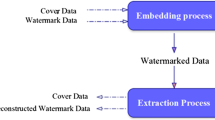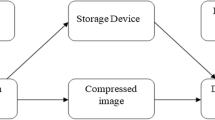Abstract
We present a technique aiming to improve the compression of the Edgebreaker CLERS string for large and regular meshes, where regularity is understood as the compactness of the distribution of vertex degrees. Our algorithm uses a specially designed context-based coding to compress the CLERS sequence. It is exceptionally simple to implement and can easily be incorporated into any existing Edgebreaker implementation which uses the Spirale Reversi algorithm for decompression. Even for irregular meshes, it does not carry considerable overhead when compared to the original Edgebreaker encoding. Experimental results show that our procedure is very fast (600000 triangles per second on a PIII 650 MHz for decompression) and leads to compression rates which are, in most cases, superior to those previously reported for large meshes of high regularity.
Similar content being viewed by others
References
Alliez P, Desbrun M (2001) Valence-driven connectivity encoding for 3D meshes. In: Eurographics ’2001 Conference Proceedings, pp 480–489
Deering M (1995) Geometry compression. Computer Graphics (Proceedings of SIGGRAPH), pp 13–20
Gumhold S, Strasser W (1998) Real time compression of triangle mesh connectivity. Computer Graphics (Proceedings of SIGGRAPH), pp 133–140
Gumhold S (1999) Improved cut-border machine for triangle mesh compression. In: Erlangen Workshop ’99 on Vision, Modeling and Visualization, Erlangen, Germany [IEEE Signal Processing Society]
Gumhold S (2000) New bounds on the encoding of planar triangulations. Technical report WSI-2001-1, Wilhelm Schickard Institute for Computer Science, Tübingen, March 2003
Isenburg M, Snoeyink J (2001) Spirale Reversi: reverse decoding of Edgebreaker encoding. Comput Geom 20(1–2):39–52
Khodakovsky A, Alliez P, Desbrun M, Schröder P (2002) Near-optimal connectivity encoding of 2-manifold polygon meshes. Graph Models 64(3–4):147–168
King D, Rossignac J (1999) Guaranteed 3.67 V bit encoding of planar triangle graphs. In: Proceedings of 11th Canadian Conference on Computational Geometry, Vancouver, BC, pp 146–149
Lee H, Alliez P, Desbrun M (2002) Angle-analyzer: a triangle-quad mesh codec. In: Eurographics ’2002 Conference Proceedings, pp 383–392
Rossignac J (1999) Edgebreaker: compressing the connectivity of triangle meshes. GVU Technical Report GIT-GVU-98-17, Georgia Institute of Technology [IEEE Trans Visual Comput Graph 5(1)]
Rossignac J, Szymczak A (1999) Edgebreaker compression and wrap&zip decoding of the connectivity of triangle meshes. Comput Geom: Theory Appl 14:119–135
Schindler M (1998) A fast renormalization for arithmetic coding. In: Proceedings of IEEE Data Compression Conference, Snowbird UT, p 572 [www.compressionconsult.com/rangecoder]
Szymczak A (2002) Optimized Edgebreaker encoding for large and regular meshes. In: Proceedings of Data Compression Conference, Snowbird, UT, p 472
Szymczak A, King D, Rossignac J (2001) An Edgebreaker-based efficient compression scheme for regular meshes. Comput Geom: Theory Appl 20:53–68
Taubin G, Rossignac J (1998) Geometric compression through topological surgery. ACM Trans Graph 17:84–115
Touma C, Gotsman C (1998) Triangle mesh compression. In: Proceedings of Graphics Interface, pp 26–34
Tutte WT (1962) A census of planar triangulations. Can J Math 14:21–38
Author information
Authors and Affiliations
Corresponding author
Rights and permissions
About this article
Cite this article
Szymczak, A. Optimized Edgebreaker encoding for large and regular triangle meshes. Vis Comput 19, 271–278 (2003). https://doi.org/10.1007/s00371-003-0208-0
Published:
Issue Date:
DOI: https://doi.org/10.1007/s00371-003-0208-0




